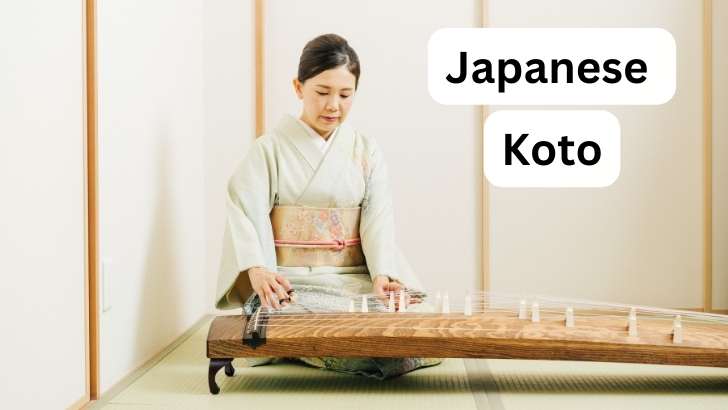
What is a Koto Musical Instrument?
The koto is a traditional Japanese stringed musical instrument, resembling a long wooden board with strings stretched across it. Players hold the koto horizontally in front of them, resting on stands. It features movable bridges called “kotoji” under each string, which are used to adjust the pitch. Sound is produced by plucking the strings with small picks worn on the fingers.
In this in-depth guide, we’ll review what the koto musical instrument is by examining what it sounds like, how it’s played, its long history, how its made, and also explore some of the great tunes and compositions it has produced over its long and varied musical history.
Lets get started with some interesting koto facts.
Koto Instrument Facts
- The koto is classified as a chordophone in the Hornbostel–Sachs system, meaning it produces sound through vibrating strings stretched between two points.
- Traditionally, a koto has 13 strings, but there are variations with up to 17 or more for different music styles.
- A person who plays the koto is called a kotoist.
- The koto is made primarily from Paulownia wood, known for its light weight and excellent resonance.
- Standard kotos are about 71 inches long (180 cm), making them one of the larger traditional Japanese instruments.
- The instrument’s strings were originally made from silk, but nowadays, nylon or tetron are more commonly used for durability and consistency of sound.
- Kotos can weigh between 11 to 13 pounds (5 to 6 kilograms), depending on the wood and size.
- This instrument is central to a genre of music known as “sōkyoku,” which is traditional Japanese court music.
- The koto’s history dates back to the 8th century, making it an instrument with a rich cultural heritage.
- The instrument has been integrated into contemporary music genres, including jazz, classical, and pop.
- High-quality, antique kotos can be quite expensive, with prices depending on the instrument’s age, maker, and materials.
- The koto is also used in educational settings in Japan, teaching students about traditional music and culture.
What does a Koto Musical Instrument Sound Like?
The koto produces a serene and delicate sound, characterized by its resonant, harp-like melodies that evoke the tranquil beauty of traditional Japanese landscapes.
Watch the video below to hear the the unique sound of this instrument.
How to Play the Koto Instrument
This koto instrument is positioned horizontally before the player, who sits on the floor or a low stool.
Sound is produced on the koto by plucking the strings with finger picks, traditionally made from ivory, bamboo, or plastic.
These picks are worn on the thumb, index, and middle fingers of the right hand. The left hand is used to press the strings against the instrument’s body or to manipulate them above the bridges to create vibrato and other expressive sound effects.
This interaction between the picks and the strings generates the koto’s distinctive, ethereal sound, which can convey a wide range of emotions, from the tranquil to the dramatic.
The movable bridges, known as kotoji, play a crucial role in the instrument’s sound production. Positioned under each string, these bridges determine the pitch and can be adjusted by the player to tune the instrument to different scales and modes.
The technique of playing the koto involves a delicate balance of hand coordination, precise timing, and emotional expression. Players must master various plucking methods, string-bending techniques, and the art of bridge adjustment to fully explore the instrument’s musical potential.
Different Types of Koto Instrument to Learn
There are several types of koto instruments, each offering a unique playing experience and sound. Individuals interested in learning the koto have a variety of options to explore, each with its own set of advantages and challenges.
Standard 13-String Koto
- Pros: This is the most traditional form, perfect for beginners to learn the basics of koto music.
- Cons: Its repertoire, while extensive, might feel limited for those seeking to explore modern compositions or fusion genres.
17-String Bass Koto (Jūshichi-gen)
- Pros: Offers a deeper, richer sound and is suitable for playing lower registers, adding depth to ensemble performances.
- Cons: Its larger size and more strings require greater finger strength and dexterity.
20-String Koto
- Pros: Provides a wider range of notes, allowing for more complex and varied music pieces.
- Cons: The additional strings can make learning and mastering this variant more challenging for beginners.
25-String Koto
- Pros: Ideal for solo performances with its expansive musical range and expressive capabilities.
- Cons: Its complexity and size demand advanced skills and make it less portable than smaller versions.
Musical Origins of the Koto
The name “koto” originates from the Chinese word “guqin,” a traditional Chinese musical instrument that shares similarities with the Japanese koto. Over time, the koto evolved in Japan, gaining its distinct characteristics and becoming a central instrument in Japanese music.
Instrument History
This table outlines the koto’s evolution from its early introduction to Japan from China to its current status as a globally recognized instrument. Initially reserved for the imperial court, the koto underwent significant transformations, notably by Yatsuhashi Kengyo in the 17th century, leading to its widespread popularity.
| Time Period | Koto Development |
|---|---|
| 7th-8th Century | The koto was introduced to Japan from China, evolving from the Chinese guqin. |
| 9th Century | The instrument became popular in the Japanese imperial court. |
| 17th Century (Edo Period) | Yatsuhashi Kengyo revolutionized the koto, making it accessible to the public. |
| 19th Century | The introduction of the 13-string koto by Yatsuhashi Kengyo. |
| Early 20th Century | Western musical influences led to the creation of new compositions for koto. |
| Late 20th – 21st Century | Innovations include electric kotos and expansion to global music scenes. |
Now that we examined the long historical development of the koto, lets now explore our understanding of the important parts of the modern instrument which produce the traditional musical sound.
Koto Instrument Description
Each part of the koto is carefully constructed from specific materials. Each contributes to its unique sound and aesthetic. The main components include the soundboard,
- Soundboard: At the heart of the koto’s construction is the body (or soundboard), primarily made from Paulownia wood (known as “kiri” in Japan). Paulownia is chosen for its light weight, fine grain, and ability to produce a resonant sound, making it ideal for the koto’s large, hollow body. This wood’s natural properties ensure that the koto can produce its characteristic warm, rich tones.
- Strings: The strings, traditionally made from silk, have evolved with the introduction of modern materials such as nylon or polyester, offering durability and a consistent tone.
- Kotoji bridge: Each string runs over movable bridges called kotoji, which are crucial for tuning. The kotoji, made from bamboo or ivory, can be adjusted along the length of the instrument to change the pitch of each string, allowing for a versatile range of sounds.
- Plectrums: Worn on the fingers of the player, they are traditionally made from ivory or tortoiseshell, although modern alternatives include plastic. These picks are essential for plucking the strings, and their material can influence the timbre and attack of the notes produced.
- Decoration: In addition to the primary materials, decorative elements such as inlays of mother-of-pearl or lacquer work can adorn the koto, reflecting the craftsmanship and aesthetic considerations in its making. These decorations do not affect the sound but signify the instrument’s cultural value and the artisan’s skill.
Famous Koto Players
The koto musical instrument has been mastered by numerous musicians who have contributed significantly to its global recognition. These artists have not only preserved traditional Japanese music but have also introduced innovative interpretations that resonate across international boundaries. Here are five renowned koto players, each celebrated for their unique contributions to the world of music.
Yatsuhashi Kengyo
Often revered as the “Father of Modern Koto.” Hailing from Japan, he revolutionized the instrument’s playing style in the 17th century, making it accessible to a wider audience and laying the groundwork for contemporary koto music.
Michio Miyagi
Born in Kobe, Japan, is credited with modernizing the koto and composing many pieces that remain staples in the koto repertoire. His work in the early 20th century bridged traditional Japanese music with Western influences, expanding the instrument’s appeal.
Keiko Nosaka
A Tokyo native, pushed the boundaries of koto music by introducing the 20-string koto. Her innovative techniques and compositions have earned her international acclaim and a place among the instrument’s most influential players.
Kazue Sawai
Born in Japan, is known for her avant-garde approach to the koto. By collaborating with contemporary composers and performers, Sawai has played a pivotal role in bringing the koto to the forefront of experimental music scenes.
Reiko Obata
An accomplished kotoist based in the United States, has made significant contributions to the instrument’s popularity in the West. Through performances, teaching, and collaborations, Obata has showcased the versatility and beauty of the koto to a global audience.
Significant Koto Traditional Music
The koto repertoire includes a vast array of traditional tunes and compositions that have been cherished and passed down through Japanses generations. Here are five traditional tunes and compositions that highlight the kotos range and its significant role in Japanese music history.
“Rokudan no Shirabe”
An iconic piece by Yatsuhashi Kengyo, composed in the 17th century. This piece, whose title translates to “Six Pieces Suite,” is a cornerstone of koto music, showcasing the instrument’s range and expressive potential. It’s considered a classic, offering listeners an introduction to the traditional koto sound.
“Haru no Umi” (The Sea in Spring)
Composed in 1929 by Michio Miyagi, this duet for koto and shakuhachi (a traditional Japanese bamboo flute) captures the essence of spring’s arrival at sea. Miyagi’s innovative fusion of Western and Japanese musical elements has made this piece a beloved standard in both traditional and contemporary repertoires.
“Sakura Variations”
Composed in the late 20th century by Tadao Sawai, this reinterprets the traditional Japanese folk song “Sakura” (Cherry Blossoms) for solo koto. Sawai’s variations explore new technical and emotional depths, illustrating the koto’s versatility and the composer’s creativity.
“Koto Vivaldi”
A more modern adaptation by Miho Yamaji, this composition blends Antonio Vivaldi’s “The Four Seasons” with the koto, offering a fascinating East-meets-West experience. This composition, created in the 21st century, demonstrates the koto’s ability to transcend cultural and musical boundaries.
“Tori no Yoni” (Like a Bird)
A composition by Toshiro Mayuzumi, composed in 1958, this is a piece for solo koto that incorporates avant-garde techniques to evoke the image of a bird in flight. Mayuzumi’s innovative approach to composition has contributed to expanding the koto’s repertoire into modern and experimental music.
The Koto in Popular Culture
The koto, with its distinct and mesmerizing sound, has left an enduring mark on various forms of media, from film to popular music, often bringing a touch of Japanese essence to international audiences.
Here is a closer look at four tunes where the koto has made a significant impact on the modern listener’s experience.
“Memoirs of a Geisha”
Composed by John Williams (2005), the film’s score, which won an Academy Award, features the koto prominently. It uses its sound to enhance the story’s emotional depth and cultural setting.
“Merry Christmas, Mr. Lawrence”
Composed by Ryuichi Sakamoto (1983), this is another example where the koto’s presence is felt, albeit subtly. Though not front and center, the instrument’s inclusion in the soundtrack adds layers to the film’s complex emotional and cultural tapestry.
“Friends”
In the realm of rock music, the koto has been explored by the band Led Zeppelin in their song “Friends” from the album “Led Zeppelin III” (1970). Jimmy Page, the band’s guitarist, used the koto to create a distinctive sound that blends rock with elements of Eastern music, showcasing the instrument’s versatility.
“The Last Samurai”
The soundtrack, composed by Hans Zimmer (2003), incorporates the koto to convey the film’s setting and the internal journey of its characters. Zimmer’s use of the koto adds authenticity and emotional resonance to the film’s exploration of Japanese culture and traditions.
Instruments Similar to a Koto
Beyond the koto, there are several instruments with similar characteristics, each with its unique cultural background and sound. Here, we explore five instruments closely related to the koto, offering a glimpse into the global tapestry of stringed musical traditions.
Guqin
The guqin is an ancient Chinese zither with a history spanning over 3,000 years. It typically has seven strings and is played by plucking the strings with the fingers. Revered in Chinese culture, the guqin is known for its subtle and tranquil sound, reflecting the principles of Confucianism and Taoism.
Gayageum
Originating from Korea, the gayageum is a traditional zither with twelve strings. It is played by plucking the strings with the fingers, producing a sound that is both vibrant and delicate. The gayageum is a central instrument in Korean court and folk music, known for its expressive depth.
Dan Tranh
The dan tranh is a Vietnamese zither similar to the koto and guqin. It usually has sixteen to seventeen strings and is played with bamboo picks. The instrument is notable for its bright and melodious tone, making it a favorite in Vietnamese traditional music.
Santoor
The santoor is an Indian hammered dulcimer with a trapezoid shape and numerous strings struck with mallets. Its origins trace back to ancient Mesopotamia, and it is a key instrument in Indian classical music, known for its rich, shimmering soundscapes.
Kanun
The kanun is a plucked zither found across the Middle East and Mediterranean regions. It typically features 26 strings grouped in threes and is played with picks attached to the fingers. The kanun is celebrated for its intricate melodies and is a staple in traditional Arabic, Turkish, and Greek music.






